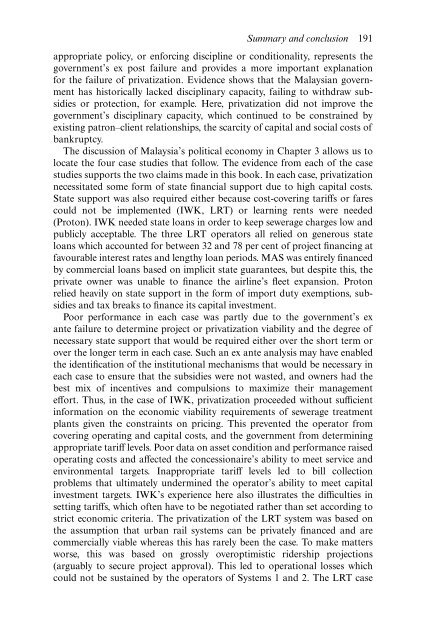PRIVATIZATION Privatization in Malaysia, Regulation, rent-seeking and policy failure
PRIVATIZATION Privatization in Malaysia, Regulation, rent-seeking and policy failure
PRIVATIZATION Privatization in Malaysia, Regulation, rent-seeking and policy failure
You also want an ePaper? Increase the reach of your titles
YUMPU automatically turns print PDFs into web optimized ePapers that Google loves.
Summary <strong>and</strong> conclusion 191appropriate <strong>policy</strong>, or enforc<strong>in</strong>g discipl<strong>in</strong>e or conditionality, represents thegovernment’s ex post <strong>failure</strong> <strong>and</strong> provides a more important explanationfor the <strong>failure</strong> of privatization. Evidence shows that the <strong>Malaysia</strong>n governmenthas historically lacked discipl<strong>in</strong>ary capacity, fail<strong>in</strong>g to withdraw subsidiesor protection, for example. Here, privatization did not improve thegovernment’s discipl<strong>in</strong>ary capacity, which cont<strong>in</strong>ued to be constra<strong>in</strong>ed byexist<strong>in</strong>g patron–client relationships, the scarcity of capital <strong>and</strong> social costs ofbankruptcy.The discussion of <strong>Malaysia</strong>’s political economy <strong>in</strong> Chapter 3 allows us tolocate the four case studies that follow. The evidence from each of the casestudies supports the two claims made <strong>in</strong> this book. In each case, privatizationnecessitated some form of state f<strong>in</strong>ancial support due to high capital costs.State support was also required either because cost-cover<strong>in</strong>g tariffs or farescould not be implemented (IWK, LRT) or learn<strong>in</strong>g <strong>rent</strong>s were needed(Proton). IWK needed state loans <strong>in</strong> order to keep sewerage charges low <strong>and</strong>publicly acceptable. The three LRT operators all relied on generous stateloans which accounted for between 32 <strong>and</strong> 78 per cent of project f<strong>in</strong>anc<strong>in</strong>g atfavourable <strong>in</strong>terest rates <strong>and</strong> lengthy loan periods. MAS was entirely f<strong>in</strong>ancedby commercial loans based on implicit state guarantees, but despite this, theprivate owner was unable to f<strong>in</strong>ance the airl<strong>in</strong>e’s fleet expansion. Protonrelied heavily on state support <strong>in</strong> the form of import duty exemptions, subsidies<strong>and</strong> tax breaks to f<strong>in</strong>ance its capital <strong>in</strong>vestment.Poor performance <strong>in</strong> each case was partly due to the government’s exante <strong>failure</strong> to determ<strong>in</strong>e project or privatization viability <strong>and</strong> the degree ofnecessary state support that would be required either over the short term orover the longer term <strong>in</strong> each case. Such an ex ante analysis may have enabledthe identification of the <strong>in</strong>stitutional mechanisms that would be necessary <strong>in</strong>each case to ensure that the subsidies were not wasted, <strong>and</strong> owners had thebest mix of <strong>in</strong>centives <strong>and</strong> compulsions to maximize their managementeffort. Thus, <strong>in</strong> the case of IWK, privatization proceeded without sufficient<strong>in</strong>formation on the economic viability requirements of sewerage treatmentplants given the constra<strong>in</strong>ts on pric<strong>in</strong>g. This prevented the operator fromcover<strong>in</strong>g operat<strong>in</strong>g <strong>and</strong> capital costs, <strong>and</strong> the government from determ<strong>in</strong><strong>in</strong>gappropriate tariff levels. Poor data on asset condition <strong>and</strong> performance raisedoperat<strong>in</strong>g costs <strong>and</strong> affected the concessionaire’s ability to meet service <strong>and</strong>environmental targets. Inappropriate tariff levels led to bill collectionproblems that ultimately underm<strong>in</strong>ed the operator’s ability to meet capital<strong>in</strong>vestment targets. IWK’s experience here also illustrates the difficulties <strong>in</strong>sett<strong>in</strong>g tariffs, which often have to be negotiated rather than set accord<strong>in</strong>g tostrict economic criteria. The privatization of the LRT system was based onthe assumption that urban rail systems can be privately f<strong>in</strong>anced <strong>and</strong> arecommercially viable whereas this has rarely been the case. To make mattersworse, this was based on grossly overoptimistic ridership projections(arguably to secure project approval). This led to operational losses whichcould not be susta<strong>in</strong>ed by the operators of Systems 1 <strong>and</strong> 2. The LRT case


